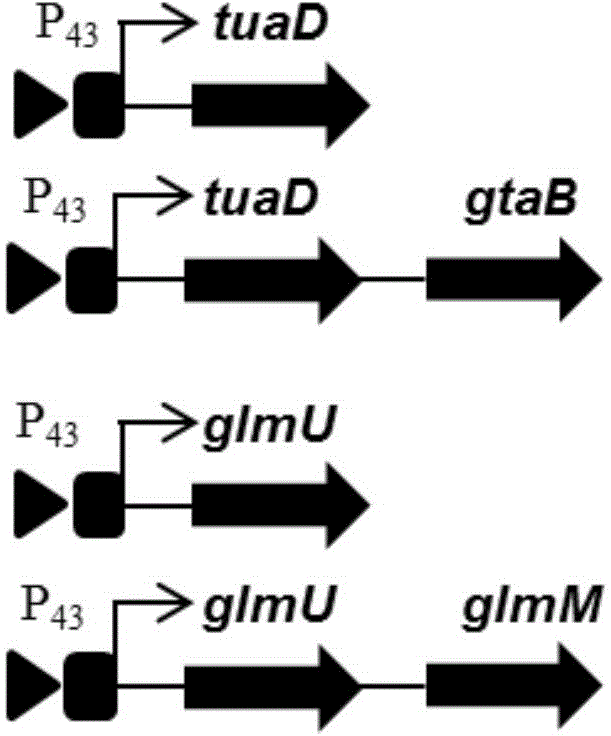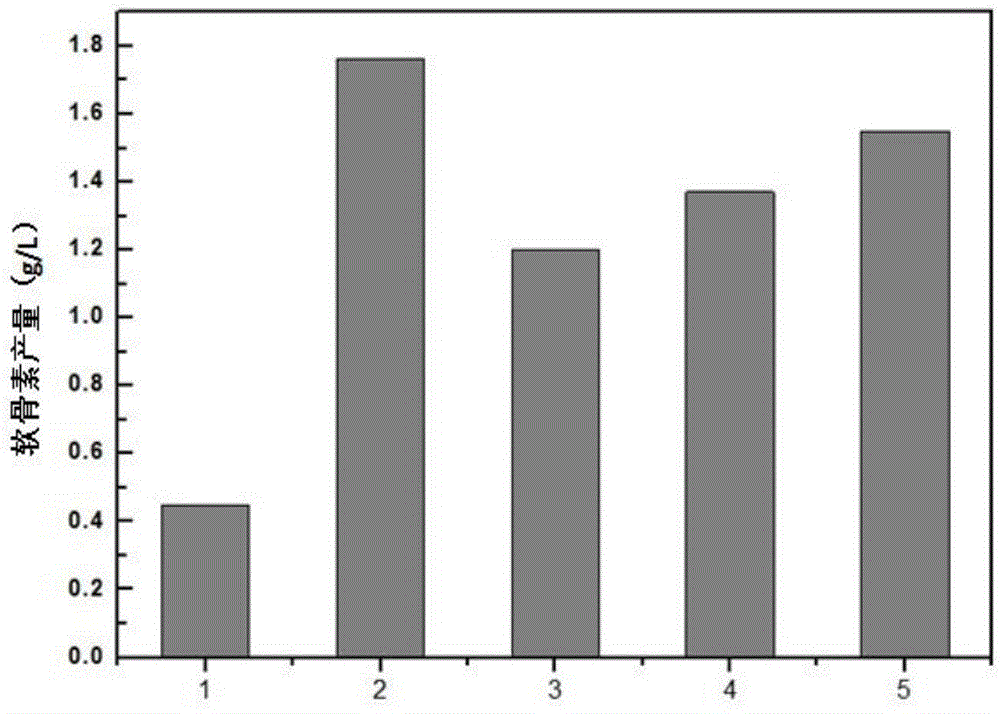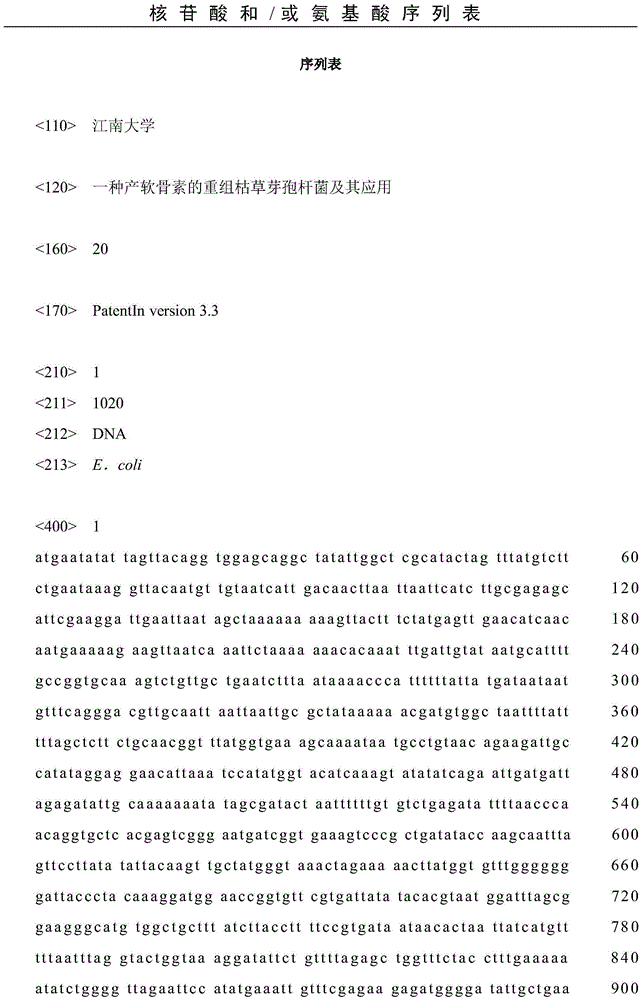Recombinant bacillus subtilis for producing chondroitin and application of recombinant bacillus subtilis
A technology of Bacillus subtilis and chondroitin, which is applied in the field of bioengineering, can solve problems such as inability to meet food medical safety requirements, and achieve the effects of high production intensity, simple culture cost, and large application advantages.
- Summary
- Abstract
- Description
- Claims
- Application Information
AI Technical Summary
Problems solved by technology
Method used
Image
Examples
Embodiment 1
[0037] Example 1 Construction of integrated recombinant plasmid pAX01-KfoC-KfoA
[0038] The UDP-GlcNAc C4 isomerase KfoA and chondroitin synthase KfoC used in this example are derived from Escherichia coli K4 (E.coli serotype O5:K4(L):H4, E.coli K4), inoculated with E.coliK4 strain In 5ml of LB liquid medium, cultured at 37°C at 200rpm for 16h. The bacterial cells were collected, and the genomic DNA of E.coliK4 strain was extracted using a bacterial genome extraction kit.
[0039] According to the published genome information sequence, primers KfoA-F / R and KfoC-F / R were designed respectively, and the KfoC and KfoA genes were obtained by using the extracted genomic DNA as a template and using a standard PCR amplification system and procedure.
[0040] Primer sequence information: 5'-3' direction
[0041] KfoC-F:CGGGATCCATGAGTATTCTTAATCAAGC
[0042] KfoC-R: TCCCCGCGGACTTCGGGTACCTTATAAATCATTCTCTATTTTTTCC
[0043] KfoA-F:CGGGGTACCAAGAGAGGAATGTACACATGAATATATTAGTTACAGGTGG
[0...
Embodiment 2
[0047] Example 2 Construction of recombinant plasmids pP43NMK / tuaD, pP43NMK / tuaD-gtaB
[0048] Bacillus subtilis 168 strain was inoculated in 5 ml of LB medium, and cultured at 37° C. and 200 rpm for 16 h. The bacterial cells were collected, and the genomic DNA of S. zooepidemicus strains was extracted using a bacterial genome extraction kit. According to the published genome information sequence of Bacillus subtilis168, primers tuaD-F / tuaD-R and gtaB-F / gtaB-R were designed respectively. KpnI restriction site and P43RBS sequence were introduced at the 5 end of the upstream primer tuaD-F, and XhoI and SacI restriction sites were introduced at the 5 end of the downstream primer tuaD-R; at the 5 end of the upstream primer gtaB-F SacI restriction site and P43RBS sequence were introduced, and XhoI and XbaI restriction sites were introduced at the 5 end of the downstream primer gtaB-R.
[0049] The primer information is as follows:
[0050] tuaD-F:CGGGGTACCAAGAGAGGAATGTACACATGAAA...
Embodiment 3
[0057] Example 3 Construction of recombinant plasmids pP43NMK / glmU, pP43NMK / glmU-glmM
[0058] Primers glmU-F / glmU-R and glmM-F / glmM-R were designed according to the published genome information sequence of Bacillus subtilis 168. KpnI restriction site and P43RBS sequence were introduced at the 5 end of the upstream primer glmU-F, XhoI and XbaI restriction sites were introduced at the 5 end of the downstream primer glmU-R, and SpeI and XbaI were used for the following genes. Homocaudal enzyme was used for ligation; SpeI restriction site and P43RBS sequence were introduced at the 5 end of the upstream primer glmM-F, and XhoI and XbaI restriction sites were introduced at the 5 end of the downstream primer glmM-R.
[0059] The primer information is as follows:
[0060] glmU-F:CGGGGTACCAAGAGAGGAATGTACACATGGATAAGCGGTTTGCAGTTG
[0061] glmU-R:CCGCTCGAGCGGACTCTAGTCTAGATTATTTTTTATGAATATTTTTCAC
[0062] glmM -F: GGACTAGTAAGAGAGGAATGTACACATGGGCAAGTATTTTGGAACAGACGG
[0063] glmM -R: C...
PUM
| Property | Measurement | Unit |
|---|---|---|
| molecular weight | aaaaa | aaaaa |
Abstract
Description
Claims
Application Information
 Login to View More
Login to View More - R&D
- Intellectual Property
- Life Sciences
- Materials
- Tech Scout
- Unparalleled Data Quality
- Higher Quality Content
- 60% Fewer Hallucinations
Browse by: Latest US Patents, China's latest patents, Technical Efficacy Thesaurus, Application Domain, Technology Topic, Popular Technical Reports.
© 2025 PatSnap. All rights reserved.Legal|Privacy policy|Modern Slavery Act Transparency Statement|Sitemap|About US| Contact US: help@patsnap.com



